Battery Management System
Zum richtigen Laden von Elektroautos tragen viele verschiedene Komponenten bei, die wir in unserer Serie Grundlagen der Elektromobilität nach und nach behandeln. Diesmal widmen wir uns dem Batteriemanagementsystem, kurz BMS.
Die Batterie ist nach wie vor die teuerste Komponente eines Elektroautos und kann bei unsachgemäßer Behandlung ihre Lebensdauer erheblich verkürzen und unter ungünstigen Bedingungen auch ein Sicherheitsrisiko für das Auto selbst und seine Besatzung darstellen. Es ist wichtig, die richtigen Bedingungen für die einzelnen Batteriezellen und damit für die gesamte Batterie zu gewährleisten, wofür das BMS zuständig ist.
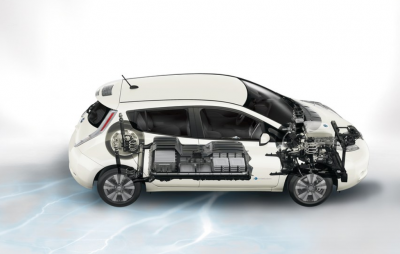
Ein Elektroauto und seine Komponenten. Autor: FirstEnergy Corp. (Lizenz CC BY-ND 2.0)
In diesem Artikel werden wir zusammenfassen, wie Batterien konstruiert werden, wir werden uns darauf konzentrieren, wie die äußere Umgebung beschaffen sein muss, damit die Batterie optimal arbeiten kann, wie das BMS konstruiert ist, was seine Hauptfunktionen sind und zum Schluss werden wir die wichtigsten Herausforderungen bei der Konstruktion eines effektiven BMS-Systems erwähnen.
Aufbau der Batterie
Obwohl die Batterie eines Elektroautos als ein einziges Bauteil bezeichnet wird, besteht sie in Wirklichkeit aus Hunderten (und manchmal Tausenden) von Batteriezellen, die in Reihe oder parallel zu Batteriemodulen verbunden sind. Diese Module werden dann zu einem Batteriesatz verbunden, den man einfach als "Batterie" bezeichnet.
Dank dieser Anordnung ist es möglich, die erforderliche Kapazität und Energie zu erreichen, und gleichzeitig ist es einfacher, sie herzustellen, zu installieren, aber auch zu überprüfen und zu warten. Wir gehen hier näher auf das Thema Batterien ein.
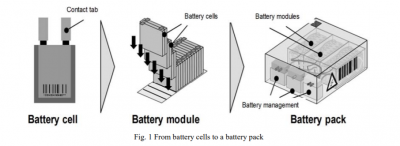
Batteriezelle, Modul und Pack. Quelle: https://www.semanticscholar.org/
Jeder Hersteller stellt die Batterie etwas anders her, verwendet andere chemische Verbindungen oder stellt Batteriezellen in verschiedenen Formen her. Es handelt sich jedoch immer um eine Art Lithiumbatterie, die die effizienteste Technologie ist, die wir bisher haben. Diese Batterien reagieren mehr oder weniger (je nach Zusammensetzung) empfindlich auf Temperaturschwankungen, Überladung oder zu starke Entladung, und um ihre Lebensdauer so weit wie möglich zu verlängern, müssen diese Mengen sorgfältig überwacht und kontrolliert werden.
Lithiumbatterien sind auch anfällig für Temperaturschwankungen, die durch verschiedene Fehler wie zu schnelles Laden oder Entladen entstehen können. Die folgenden Diagramme zeigen den so genannten Sicherheitsbetriebsbereich. Der grüne Kasten stellt die Bedingungen dar, unter denen Lithiumbatterien sicher sind und am besten funktionieren. Die Temperatur sollte zwischen -5 und 45 °C liegen, die Spannung zwischen 2 und 4 Volt und der Strom zwischen 0 und 1 A. Es ist von größter Wichtigkeit, die Batterie sorgfältig zu überwachen und sicherzustellen, dass sie sich in diesem "sicheren Betriebsbereich" befindet.
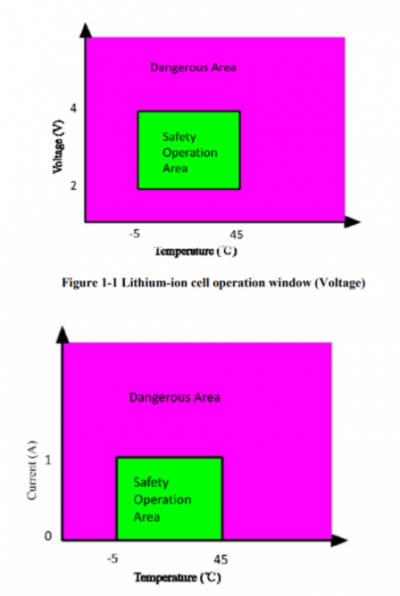
Bereich Sicherheitsbetrieb. Quelle: file:///C:/Users/Datart/Desktop/Batteriemanagementsystem für Elektrofahrzeuganwendungen.pdf
BMS-Konstruktion
Der Aufbau des BMS entspricht weitestgehend dem Aufbau der Batterie. Es besteht aus einer integrierten Schaltung zur Batterieüberwachung (BMIC), einem Zellmanagement-Controller (CMC) und einem Batteriemanagement-Controller (BMC).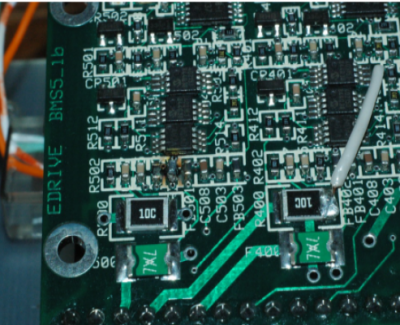
Sistema de gestión de batería. Autor: carrott (Licence: CC BY 2.0)
Die BMIC überwacht die einzelnen Batteriezellen und muss in der Lage sein, das CMC schnell - in wenigen Mikrosekunden - über die Situation zu informieren, damit das CMC oder BMC reagieren und gegebenenfalls eine ungünstige Situation korrigieren kann. Um ein Auslaufen der Temperatur zu verhindern, muss die BMIC die überhitzte Batteriezelle sofort bemerken und diese Information so schnell wie möglich weiterleiten. Das BMC muss entscheiden, wie ernst die Situation ist, wie weiter verfahren werden soll, und die überhitzte Zelle muss gegebenenfalls abgeschaltet werden. Und das alles muss innerhalb eines Wimpernschlages geschehen.
Die Genauigkeit der Messung und die Fähigkeit, auf ungünstige Bedingungen zu reagieren, hängen in erster Linie von der Häufigkeit der Kommunikation zwischen der BMIC, der CMC und der BMC ab: Je häufiger sie miteinander kommunizieren, desto größer ist die Chance, dass sie eine möglicherweise riskante Situation erfolgreich lösen. Allerdings ist es aufgrund des elektrischen Rauschens gar nicht so einfach, ein effektives Kommunikationsnetz in einem Elektroauto aufzubauen.
Neben den Modulen BMIC, CMC und BMC besteht das BMS daher auch aus Schaltkreisen, die die Energielasten der verschiedenen Zellen ausgleichen, so dass alle Zellen mehr oder weniger gleich arbeiten und nicht zu Problemen neigen. Das Thema Nivellierung ist so wichtig, dass wir es später noch viel ausführlicher behandeln werden.
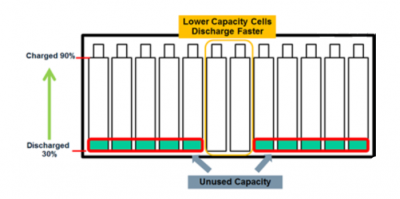
Unused battery cells. Source: https://www.analog.com/en/technical-articles/active-battery-cell-balancing.html
Je nachdem, wie kompliziert das Elektroauto ist, können mehrere intelligente Mikrocontroller zur Überwachung und Steuerung verschiedener spezifischer Aufgaben hinzugefügt werden. Jedes BMS muss in der Lage sein, nicht nur die Batterie, sondern auch sich selbst zu überwachen, und es muss feststellen können, ob Alarme oder Aufforderungen echt und nicht gefälscht sind.
Grundlegende Funktionen von BMS
Die Funktionen eines BMS sind mehr als offensichtlich, aber um sie zusammenzufassen, werden wir sie nacheinander aufzählen und kurz bei jedem einzelnen Punkt verweilen.
1. Entlade- und Ladesteuerung
Das Laden und Entladen sind die riskantesten Momente im Leben einer Batterie. Bei der Wechselstromladung wird die Ladesteuerung teilweise vom eingebauten Ladegerät übernommen, das für die Umwandlung des Wechselstroms in Gleichstrom zuständig ist, der dann in der erforderlichen Spannung an die Batterie weitergeleitet wird. Bei der Gleichstromladung geht der Strom direkt an das BMS, das den Ladevorgang steuert und mit der Gleichstromstation kommuniziert.
Diese Funktion erfordert ein intelligentes System, da sich die Parameter der Batterie selbst im Laufe der Zeit ändern (Oxidation an den Klemmen, Veränderung der Kapazität der Batteriezellen usw.) und die Ladung sich immer in Echtzeit daran anpassen muss.
2. Bestimmung des aktuellen Ladezustands (State of Charge
Dies ist eine der wichtigsten Funktionen, dank derer das BMS dem Fahrer mitteilen kann, wie lange er noch fahren kann. Aber die Bestimmung des Ladezustands ist nicht so einfach, wie es scheint. Es handelt sich um eines der komplizierteren Probleme bei der Entwicklung von BMS-Systemen.
Der aktuelle Ladezustand ist definiert als das Verhältnis zwischen der verfügbaren Kapazität und der Gesamtkapazität der Batterie und kann daher jeden Wert zwischen 100% und 0% annehmen. Da es sich bei der "Entladung" der Batterie um einen Elektronenfluss handelt, scheint es, als könne nur die Menge der Ladung oder Entladung gemessen werden. Der Verbrauch wird jedoch von vielen Variablen beeinflusst, wie z. B. der aktuellen Temperatur, der Temperaturänderung während der Entladung, der aktuellen Belastung und vielem mehr, so dass es alles andere als einfach ist, all diese Faktoren zu berücksichtigen
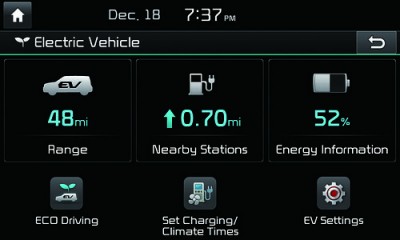
"KIA Future Infotainment System - CES 2014 - (5) - SMADEMEDIA.COM Galleria" by THE SMADE JOURNAL is licensed under CC BY 2.0
Determining the right value of state of charge is also complicated by the fact that the methods of accurate measurement are either too computationally complex or insufficiently accurate, and in addition the state of charge depends also on the parameters of the whole battery that change during its life, i.e. it depends on the state of health of the battery, which is even more complicated to determine.
As accurate measurement is not possible or is extremely impractical, the current state of charge is based on computer battery models. It is an estimate, though a qualified one. In the next chapter, we will focus on battery models a little more thoroughly.
3. Bestimmung des Gesundheitszustands
Der Gesundheitszustand einer Batterie ist definiert als das Verhältnis zwischen der aktuellen vollen Kapazität und der vollen Kapazität der Batterie bei 0 km. Wenn Sie eine Batterie kaufen, hat sie einen Gesundheitszustand von 100 %, der sich mit den Ladezyklen verschlechtert.
Viele Studien sind sich einig, dass der Gesundheitszustand der Batterie von der Temperatur, dem Ladestrom, der Anzahl der Ladezyklen und anderen wichtigen Faktoren beeinflusst wird. Allerdings sind nicht alle Vorgänge in der Batterie vollständig bekannt, so dass es keine genauen Methoden zur Bestimmung des Batteriezustands gibt. Wie bei der Bestimmung des Ladezustands muss man sich auf ungefähre Computermodelle stützen, die den Innenwiderstand, die Leitfähigkeit, die Selbstentladungsrate, die Kapazität, die beim Laden aufgenommene Energie, die Temperatur während des Gebrauchs, das Alter, die Anzahl der Zyklen usw. berücksichtigen.
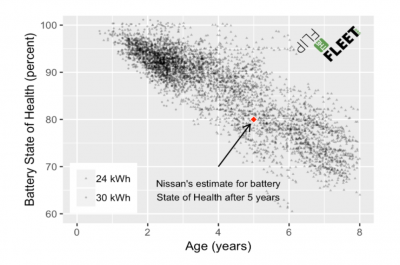
State of health of Nissan Leaf batteries over time. Author: Flip the Fleet. Source: https://flipthefleet.org/resources/benchmark-your-leaf-before-buying/
So far, there is no exact agreement between individual manufacturers which variables enter into the calculations and which models are to be used. Research and development continues to focus intensively on these topics. And as mentioned above, determining the state of health correctly is crucial to be able to determine the state of charge as closely as possible.
4. Charge balancing
Balancing the charge and discharge of individual cells is the last puzzle that every BMS must solve and which we have not yet sufficiently addressed, but it is actually one of the most important functions that the whole battery lifespan depends on. The same level of discharge and charge of each cell is important so that some cells are not overloaded and destroyed.
No two battery cells are ever exactly alike. Some always have a bit bigger or smaller capacity. Battery cells that have a slightly lower capacity discharge faster and are also destroyed faster, while the capacity of other cells remains unused. In the same way, during charging, the weakest cells are charged first and the others are only partially charged.
Balancing the charge and discharge of individual cells thus significantly increases the overall capacity, because it is not only determined by the weakest cells, and it also protects these weaker cells, so they are not damaged, shorted or leaked, which could damage the entire battery pack. In the section on BMS development, we will focus more deeply on active and passive balancing and different types of topology.
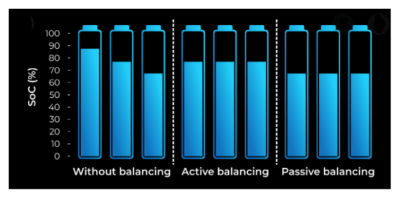
Active and Passive balancing. Source: https://www.ionenergy.co/resources/blogs/cell-balancing-battery-life/
5. Recording and communication
Compared to the previously mentioned functions, recording and communication is a relatively easy function. Because the health of the battery is a relative quantity, the BMS needs to store data on what the battery's characteristics were at the beginning so that it can compare it with other values. Thanks to this, it enables the evaluation of the battery operation, as well as its diagnostics.
Equally important is communication between the BMS and other parts of the car such as the on-board charger or charging station. The BMS also ensures that the driver's display shows how far he has traveled or when the car needs to be recharged. It is also possible to access the aforementioned history, which the BMS stores and processes.
BMS development
In order for each BMS system to be able to perform its functions correctly, several puzzles need to be overcome for its development. As we have said before, we will focus on two. The first is the Battery State Estimation. This is a value that is important both for the driver and for the system itself and its proper management.
The second is Battery Cell Charge Balancing. There are passive and active methods, as well as various active balancing topologies that need to be properly designed to optimize BMS properties.
Battery State Estimation
The state of charge of the battery is absolutely essential information for the driver. Moreover, the use of the battery could be extended if it was possible to obtain an accurate value. However, this is a complicated problem. We have already explained why this quantity cannot simply be measured and why we have to rely on qualified estimates. Today, there are three basic estimation methods - the ampere-hour method, the open circuit voltage (OCV) method and model-based methods.
The ampere-hour method is simple and easy to implement. However, in order for it to function properly, it needs the original knowledge of the state of health (which is also only an estimate) and it is negatively affected by accumulated errors and measurement errors, and over time it becomes impractical. The open circuit voltage measurement method is also considered accurate. But it can be used only if the car has rested for a long time, so it is difficult to use it in normal operation.
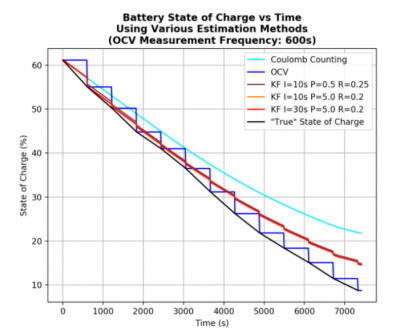
Various methods determining battery state of charge. Author: Jack O'Grady. Source: https://www.jackogrady.me/battery-management-system/state-of-charge
Due to all the mentioned shortcomings, model-based methods are the most common solution. Both voltage and current measurements are used. The measured current is entered into the model and the voltage is calculated using the value of the current and / or past values and parameters. The difference between the calculated and measured voltage is then inserted into an algorithm that is able to cleverly update the estimated state.
The use of intelligent logarithms, fuzzy logic, artificial neural networks and other possibilities are being investigated. Due to their excellent ability to approach nonlinear functions, these methods can achieve very accurate estimates, but the learning process required to use these options is computationally complex, making it difficult to use them in the necessary applications.
Computer models of batteries
Creating computer models of batteries, according to which it would then be possible to calculate the charge level, is complicated because it is a strongly nonlinear system. There are basically two options. The first are electrochemical models that use the electrochemical properties of the battery. And although this method is relatively accurate, in practice it is computationally complex and so several equivalent circuit models are used instead. These circuit models are widely used to estimate battery status, but their problem is that they are not as accurate.
Current research focuses mainly on the development of more accurate models, or on a combination of the current ones (electrochemical and circuit) in such a way that they are not so computationally demanding and the goal is to eventually use them in electric cars.
Battery cell charge balancing
There are no two identical battery cells in the world (or two identical batteries). Differences can be in internal resistance, level of degradation, capacity, ambient temperature, and many more. These inevitable differences between cells can cause many problems, and overall capacity can be dramatically reduced. This imbalance then causes the individual cells to be over-discharged or over-charged, which is dangerous for the battery pack as a whole, and thus charge balancing between the individual cells is of paramount importance to maintain performance and extend battery lifespan.
Passive charge balancing methods
The passive method means that the cells that have more energy than others, are discharged by resistors and the excessive energy is dissipated as heat. By discharging the excess energy from the fuller cells, the battery pack can easily be balanced.
However, this method wastes too much energy and also complicates the thermal control of the entire battery. Moreover, in this case, only overcharged batteries work, and if one battery cell is significantly weaker than others, more energy is discharged during balancing than during driving.
Active charge balancing methods
Active switching circuits are used for active balancing, which are able to transfer energy between individual cells. Unlike passive methods, only a small amount of energy is wasted. But in order to achieve this, more components need to be built into the circuit, which not only leads to a higher cost, but also to reduced reliability.
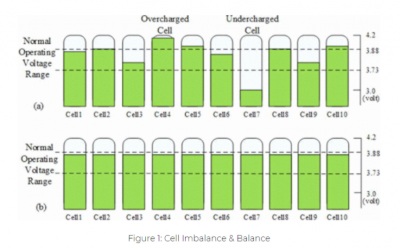
Balanced and unbalanced battery pack. Source: https://www.ionenergy.co/resources/blogs/cell-balancing-better-performance/
Active balancing occurs through a variety of strategies called topologies, which take into account cost, complexity, and reliability. As always, there's a trade-off. With the simplest and therefore the most reliable topologies, a cell can only balance another cell that is right next to it, which is insufficient if the unbalanced cells are farther apart.
To effectively connect all the cells so that their alignment can be flexible, too many components are needed and thus become unreliable and expensive. The third method, which allows for a small number of components and flexibility, is too slow to be effective in practice, as two adjacent cells are gradually aligned until a homogeneous charge is achieved.
As this is a fundamental function of BMS, much effort is devoted to designing the most efficient topologies and using the best strategies, both passive and active balancing, using as few components as possible. We can surely expect many new things to come in these segments.
In conclusion
BMS is a part of electric cars, which we do not hear about as often as, for example, the battery, but its function is completely irreplaceable. It is the BMS that protects the battery from misuse and damage, prolongs battery life and ensures that the battery is always ready for use.
However, every design always brings the need to balance the price, efficiency and longevity of each system. The only value that is never discounted is security. All components must meet ISO 26262 security standards, so each BMS must be fail-safe and contain redundant resources, such as processor units, each of which must have its own dedicated devices, such as memory, and more.
In terms of the importance and safety of the car and crew, the BMS is definitely an underestimated part of the electric car and deserves the same attention as the battery itself (if not bigger).
